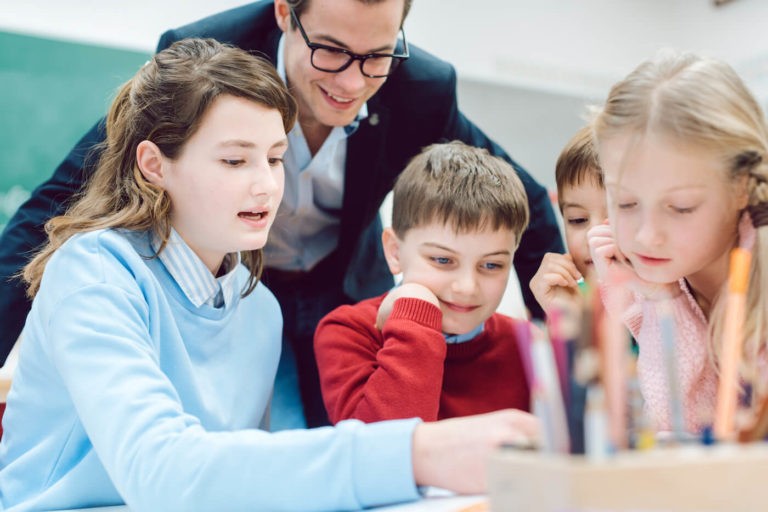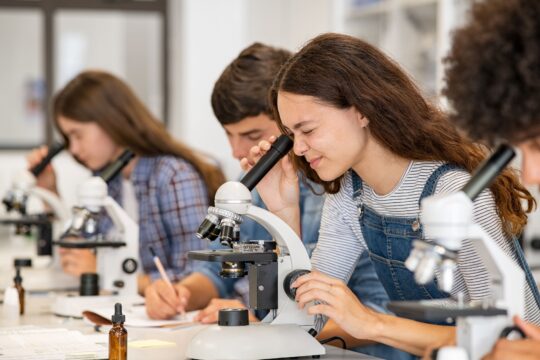According to the Collaborative for Academic, Social and Emotional Learning (CASEL), an education that includes Social and Emotional Learning (SEL) results in improved outcomes in student achievement, health, employment, psychology, economic well-being, and pro-social behaviors. SEL is a habit, and as such it must be practiced daily. In addition to seeking out resources related to best practices in the classroom, schools should consider creating a schoolwide SEL program such as the one described in The CASEL Guide to Schoolwide SEL Essentials.
An Introduction to SEL
Before implementing SEL strategies, lead a discussion on the importance of being self-aware, mindful, and able to regulate one’s emotions. There are videos available online that introduce the concept of emotions to children of all ages through the words of their peers. This helps students understand that it is normal to have feelings, even unpleasant or negative ones. By demonstrating that students are not alone in their emotions, a feeling of safety and a sense of curiosity can be established.
After thinking about feelings and how they manifest, review with students the science behind their feelings. Display a diagram on the board with these systems labeled, and show students how to use their hand to model the regions of their brain. The science behind feeling sets the stage for students to understand the “why” behind their feelings, and to begin to understand that there are strategies to help influence our brain and the way it interacts with our world.
Establishing Predictability & Creating Safety
In order to answer the question “Am I safe?”, teachers should lead students through the process of creating class norms or social contracts in which student establish how we all agree to treat one another in the classroom. Once class norms are established, they should be posted visibly for all to see (along with visual reminders of all instructional and non-instructional routines), initialed by students in order to help them take ownership, and revisited often in order to ensure their continued relevance to the members of the class.
By establishing routines and rituals, use predictability to create a feeling of safety. Rituals should be established and adhered to on a daily basis including greeting students with a handshake, their name, and a smile. Additional rituals include asking students to send well-wishes to absent classmates, creating jobs in the classroom with specific assignments related to ensuring that everyone feels safe enough to be successful at school, or taking one to two minutes each class period to allow students to share “Good Things” with the class. Using an optimistic closure is another ritual that can help launch a child into the rest of their day with inspiration and optimism.
Class meetings are another way to establish classroom safety and predictability. Consider creating a schedule of events for class meetings and rotating through different SEL activities with different purposes each day of the week: Check-in, unity, mindfulness, connection, and commitment.
Check-In Activities
Check-in activities promote self- awareness and self-management and help students regulate emotions and increase focus. Examples of check-in activities include displaying a visual such as a Mood Meter, feeling wheel, emoji chart, or even pictures of the weather, and asking students to pick which image or word best describes how they are feeling today. This can be done anonymously through a polling app like mentimeter or students can use sticky notes on a blackboard with their names written on the back.
In an emotionally safe classroom, clips with student names on them can be placed in an appropriate place on a continuum, each day to show how everyone is feeling. Other check-in activities ask students to identify things that are in and outside of their control or complete a feeling cycle that identifies things they are concerned about, thankful for, and needing help with. Students can also draw pictures of themselves that show how they look on the outside versus how they are feeling on the inside.
Activities to Connect
When students connect with each other and the teacher, their bodies release oxytocin, and this promotes connection and reduces aggression. Students can connect with others by finding someone they have something in common with and looking them in the eye, greeting them by name, and performing an appropriate body language greeting (high five, handshake, fist bump, or butterfly greeting, elephant greeting, etc.). Teachers can also use the four corners activity model to have students group themselves by common interest (art/music, sports, video games, reading) or by attributes they have in common (birth order, favorite subject, special talent, etc.). By reshuffling the groups a few times, teachers can help students see commonalities and form connections with new peers.
Activities to Unite
Activities that unite ask the whole class to do something altogether, by asking everyone to participate and giving everyone access, these activities foster safety and release endorphins. Uniting activities include:
- Dance Party – Play one minute of music and ask everyone to dance
- Pat/Clap/Outward High 10 – The leader establishes a pattern of hand movements that everyone follows
- Recite a chant or rap together
- Mimic a movement – This can be especially fun if students are willing to demonstrate the movement that everyone models
- One-word whip around – Say one word that is a positive attribute about you or something you are grateful for (establish the order ahead of time).
Activities to Disengage Stress
In order to help students turn off the stress response in the brain and prepare for learning, lead students through mindfulness and breathing techniques. Teaching a variety of techniques can be both helpful and fun for students. Stretching can also relax students mentally and physically, and there are a variety of yoga videos and guides for different age groups available online, including some that prompt students to perform yoga poses reminiscent of animals in nature.




